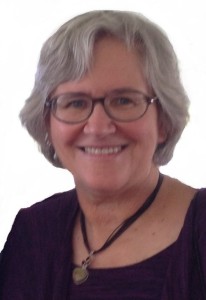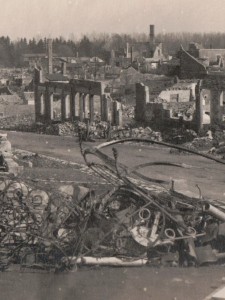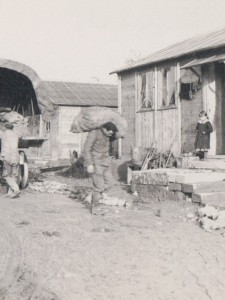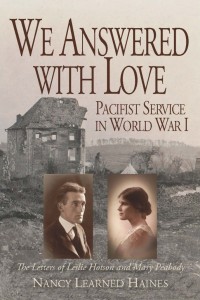Under what conditions would the Quakers, renowned pacifists, team up with an army? Historical non-fiction author Nancy Haines describes what happened in Verdun, France 100 years ago.
~~~
 Relevant History welcomes Nancy Haines, who worked seventeen years as an engineer, then ran an antiquarian bookstore. After her retirement, she fulfilled a lifelong dream to be an author. She published a nonfiction book, We Answered with Love, about Quaker relief service in France during WWI based on the love letters of two pacifists, and a picture book about spiritual decision making for Quaker children. She is currently researching the lives of the Quakers who were the original European settlers of Hillsborough, North Carolina, where she and her husband now reside, for a nonfiction book (or possibly try her hand at a novel). To learn more about her and her books, visit her web site.
Relevant History welcomes Nancy Haines, who worked seventeen years as an engineer, then ran an antiquarian bookstore. After her retirement, she fulfilled a lifelong dream to be an author. She published a nonfiction book, We Answered with Love, about Quaker relief service in France during WWI based on the love letters of two pacifists, and a picture book about spiritual decision making for Quaker children. She is currently researching the lives of the Quakers who were the original European settlers of Hillsborough, North Carolina, where she and her husband now reside, for a nonfiction book (or possibly try her hand at a novel). To learn more about her and her books, visit her web site.
*****
The American Army fights wars, and the Quakers are pacifists. But 100 years ago, at the end of World War I, the Army and the Quakers worked together in France to relieve some of the suffering that had been inflicted on the French citizens. Since 1917, Quakers (a.k.a. Friends) from Britain and America had been working in France, building houses, establishing medical centers for civilians, and doing agricultural work. Now that refugees could return to their villages, Friends would be able to provide vital support in helping to repair buildings, distribute furniture and bedding, supply seeds and farm tools, loan out heavy agricultural equipment, and provide medical services to the French people.
Work in Verdun
 The Quakers decided to concentrate their work in Verdun, the region that was hardest hit by the German invasion. As the Allies advanced northwest of Verdun, the Army gave Quaker workers permission to move in to meet the needs of over ten thousand refugees. The fighting had been almost continuous in this area. Only about five percent of the houses were left standing and these were badly damaged. One British worker described the abandoned battlefields:
The Quakers decided to concentrate their work in Verdun, the region that was hardest hit by the German invasion. As the Allies advanced northwest of Verdun, the Army gave Quaker workers permission to move in to meet the needs of over ten thousand refugees. The fighting had been almost continuous in this area. Only about five percent of the houses were left standing and these were badly damaged. One British worker described the abandoned battlefields:
On all sides can be seen the debris of an army: shells, cartridges, rotting clothes and boots, and rusty food tins by the hundreds. It is these last which give an air of everyday reality to the scene which otherwise (so bare and blasted as it is) might be taken almost for a freak of the imagination or the work of some supernatural power. When one sees a ‘Skipper’ sardine tin amongst all this chaos, then with a jump one is brought to the astounding fact that all this destruction is the work of modern civilisation and that all the resources of civilisation are behind it.
 With financial assistance from the French government, the Quakers occupied the former divisional headquarters of the French and American armies. This center included barracks for the workers and barns to store supplies to support the workers, goods to be sold to the villagers, agricultural machinery, stables and breeding barns for livestock, and generators for electricity. The American Army provided trailers and fuel for distributing the supplies and building materials to the villages.
With financial assistance from the French government, the Quakers occupied the former divisional headquarters of the French and American armies. This center included barracks for the workers and barns to store supplies to support the workers, goods to be sold to the villagers, agricultural machinery, stables and breeding barns for livestock, and generators for electricity. The American Army provided trailers and fuel for distributing the supplies and building materials to the villages.
The American Army also gave Friends access to five depots or “dumps” of material and supplies that the Allies had abandoned as they withdrew from the region. Rufus Jones, in his book about the relief work in France, reported that “this material covered many acres at each “dump” and consisted of lumber, bar-iron and steel, farm and road implements of every sort, miles upon miles of barbed wire, and an almost indescribable mélange of all material which might be useful in a modern war.” The French government also allowed Friends to salvage from some of the German abandoned materials, and the national railroads agreed to carry it free of charge.
Restoring community life
The primary task in this region was to help the returning residents become independent so that they would only rely on the government for a limited time. Quakers established canteens in each village to feed the refugees until they were able to provide for themselves, hostels for people who had no other shelter, and schools for young children. The French government provided repatriation money to the residents of the villages, and the American Army supplied some equipment and transported materials. Their support enabled the Quakers to set up cooperative stores selling building materials, furnishings, and other necessities at or under cost, including many of the items they salvaged from the military dumps. When these stores became financially viable, they were turned over to the villagers to operate with the profit remaining in the community.
The French government encouraged French citizens to do the reconstruction work, so the Friends employed refugees at the headquarters and in the building projects, partly for wages and partly in exchange for the services they received. On some properties, farming was no longer viable because of the poor soil, trenches and shell holes, and the possible presence of unexploded bombs. Friends gave these families sheep, goats, pigs, chickens, and rabbits to raise and allowed them to use the barns at the former Army headquarters until their own sheds and corrals were built.
Employing German prisoners
The Allies offered the Friends the labor of German prisoners of war to help sort and load this material. The Friends were not permitted to pay the Germans, but many were willing to work to relieve the boredom. Quakers gave each German helper an opportunity to write a letter to his family and have his photograph taken. With passes provided by the Army, three Quakers undertook the arduous journey to Germany. They visited three hundred families of the prisoners, providing letters and photographs showing that their sons or husbands were in good health (unlike the German families themselves who were often undernourished and suffering). They also brought wages estimated to cover the value of the labor given by the men. Although the prisoners did not return to Germany for many more months, the visit of the Friends offered encouragement to their suffering families and the funds to help alleviate some of their hardships.
Leaving France
By early summer, the work of the Quakers had begun tapering off. They had laid the groundwork for restoring community life in the villages. Homes had been built or restored. Cooperative stores, schools, community centers, and agriculture were being run by French citizens. Finally, by the spring of 1920, the Quakers were able to turn their attention to new projects in Poland and Austria. The Quakers who had toiled in France went home to England and America or on to new postings.
*****
 A big thanks to Nancy Haines! She’ll give away one paperback copy of We Answered with Love to a reader who contributes a comment on my blog. I’ll choose the winner from among those who comment by Friday at 6 p.m. ET. Delivery is available worldwide.
A big thanks to Nancy Haines! She’ll give away one paperback copy of We Answered with Love to a reader who contributes a comment on my blog. I’ll choose the winner from among those who comment by Friday at 6 p.m. ET. Delivery is available worldwide.
**********
Did you like what you read? Learn about downloads, discounts, and special offers from Relevant History authors and Suzanne Adair. Subscribe to Suzanne’s free newsletter.

What an interesting story. I had known that a number of Quakers were ambulance drivers during WWI but knew nothing of the relief work. Look forward to reading your book.
Thank you. Quakers were very involved in relief work during World War I and World War II — they refused to fight, but they also felt that they had a responsibility to do something during the war.
Your book is a excellent learning experience for all of us readers and writers.
Thank you, John. I look forward to your next novel about Puerto Ricans who fought in the Korean War.
Pingback: When Soldiers and Pacifists Were On the Same Team | Nancy Learned Haines
This brought me to tears. I worked for AFSC when we were gathering testimonies about its 90 years of work. Amazing stories about relief work in Europe during the 1920s, but I hadn’t read about this. Thank you!
Thank you for your comment. This was the first project of the AFSC — started out as the Friends Reconstruction Unit. AFSC celebrated 100 years in 2017. They have done great work since then and are still going strong.
My late husband’s family were Quakers with many of them in North Carolina. I didn’t know about the history of the Friends working with refugees in Verdun and wish I could share this information with him.Maybe some of his relatives participated. I will have to see what I can find out via Ancestry.
Thank you for your comment. Rufus Jones wrote a book about the Friends work in France. In appendix A is a list of all the men and women who were part of the work. The whole book is online — scroll down or skip to appendix A. Maybe your relatives are listed there.
https://archive.org/stream/serviceofloveinw00jone/serviceofloveinw00jone_djvu.txt
Thomas Paine was a Quaker and many Quakers helped and assisted in the American Revolution esp as spies. Stands to reason they would assist in other wars for freedom and liberty.
Thank you for your comment. Some Quakers even fought in the American Revolution — their meeting was called the Free Quakers. This included Betsy Ross, Nathanial Greene, and others.
Belinda and Nancy,
During the American Revolution, the Continentals were fortunate to have the military skills and moral compass of General Nathanael Greene, aka “the Fighting Quaker.” Check out Helena Finnegan’s Relevant History essay about Greene from several years ago:
http://www.suzanneadair.net/2014/07/03/general-nathanael-greene-the-complete-package/
I expect historians to release more information about him in the next few years, as the 250th anniversary of the Revolution approaches.
Very interesting post so I’ve followed your site, Nancy. I’ve always admired Quakers and belonged to the Peace Pledge Union in the UK, some years ago. My ancestors on my paternal grandmother’s side were Quakers, including Elizabeth Fry nee Gurney’s sister. She was married to Sir Thomas Fowle Buxton who led the abolitionists in Parliament after William Wilberforce died.
Thank you for your comment and for visiting my website. Elizabeth Fry was a remarkable woman and, for a while, even appeared on a banknote in Britain. Elizabeth was married to Joseph Fry. Her sister Hannah was married to Thomas Fowle Buxton — a remarkable family all around.
Fascinating article which can encourage us all to do what we can to help in other war or disaster situations. So often the ‘red tape’ involved makes me want to give up before I’ve begun. In WW1 there was less of that, and it is amazing how so much was organised without the benefit of computers, email or social media! The Quakers were and are a wonderful example of compassion in action.
I am amazed that so many people stepped up to help others during the war, instead of staying safely at home. Thank you for commenting on my post.
A review posted on Goodreads about the American Women’s Hospital, Mercy Road by Ann Howard Creel, had me checking Wikipedia. No specific mention of Quakers, so unsure whether related.
Quakers weren’t the only ones providing relief services in France — thank goodness. There was more than enough work to go around for Mennonites, the American Red Cross, British pacifists, etc. even an ambulance service from Harvard University. I appreciate the reference. I will look for the book.
I wish that I had studied history more extensively at any time; alas, there’s no time like the present, and WWI is an area of history I know very little about. Thank you for this.
I agree — I knew very little about World War I when I started my research. I didn’t spend much time following the battles, etc., but the relief workers, medical support teams, and ambulance volunteers had very interesting stories to tell. And really showed the horrible effects of the war on ordinary citizens.
I had no idea that the Quakers provided such relief for war torn areas. How compassionate they were to bring letters to the families of the prisoners. War is such a horrible thing. Men (and now women) risking their lives for ridiculous reasons. I cannot, nor do I want to think about the death of innocents and the destruction America has caused others.
I agree with your observation. The visits to the families of prisoners was unique and had to have been very much appreciated. The kindness shown to the prisoners ensured that no one escaped while they were on work duty (one did but he returned.)
One of my relatives, Herbert Babb, was among the Quakers restoring homes in Verdun from 1916 until 1919. I have a long letter that he wrote to his aunt in 1918 in which he describes the devastation and the efforts to restore homes. He mentioned that many of the workers returned to the U.S. following the end of the was, but that he and others decided to remain.
Your relative was there right from the beginning of the Friends work in France. Many who were there that long, were tired and went home. I am impressed that he remained. As the letters in my book and the one you have addressed to your aunt show — there was still a lot to be done after the war ended to enable the French residents to return to their homes. Thank you for the information about your relative.